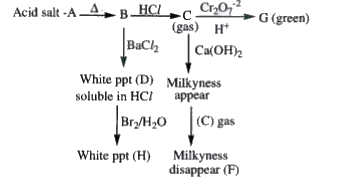COLUMN-ICOLUMN-II(Elements)(Covalency)(A)'O' atom in O3(p)1(B)'S' atom in hyposulphorous acid(q)2(C)'N' atom in NO+andN2O4(r)3(D)'N' atom in N3H(s)4 Solution in Telugu
The correct Answer is:A-p,q,r; B-s; C-r,s; D-q,r,s
A) Covalency = No. of covalent bond  , Middle = 3, Oxygen (a) = 2, Oxygen (b) = 1
, Middle = 3, Oxygen (a) = 2, Oxygen (b) = 1
B) H2S2O4= Hyposulphurous acid C)  D) H−⋅⋅N=⊕N=⋅⋅⊕N:
D) H−⋅⋅N=⊕N=⋅⋅⊕N:
Topper's Solved these Questions
- BOOK - AAKASH SERIESCHAPTER - VIA GROUP ELEMENTSEXERCISE - PRACTICE SHEET - 5 ( Integer answer type Questions)6videos
VIA GROUP ELEMENTS
- BOOK - AAKASH SERIESCHAPTER - VIA GROUP ELEMENTSEXERCISE - PRACTICE SHEET - 5 (Linked Comprehension type questions)3videos
VIA GROUP ELEMENTS
- BOOK - AAKASH SERIESCHAPTER - VA GROUP ELEMENTSEXERCISE - PRACTICE EXERCISE51videos
VA GROUP ELEMENTS
- BOOK - AAKASH SERIESCHAPTER - VII GROUP ELEMENTSEXERCISE - OBJECTIVE EXERCISE -455videos
VII GROUP ELEMENTS
Similar Questions
When This sulphate ion is oxidized by iodinc, new product 'X' is formed. The number of s-s linkage isi/are present in 'X'?
03:59View SolutionPassage-II:

'C' is02:33View SolutionWhich of the following reacts rapidly with oxygen in the air at ordinary temperature?
05:10View Solution(A): The bond dissociation energy of fluorine is less than bromine.
(R): In fluorine molecule, large lone pair electronic repulsions and appreciable internuclear repulsions are present.04:11View SolutionStatement-I : 16g each O2 and O3 contains NA2 and NA3 atoms repectively
Because
Statement-II : 16g of O2, and O3 contains same no. of atoms.08:51View Solution{:("Column-I",,"Column-II"),("(A) " BF_(4)^(-),,"(P) All atoms are p-block members"),("(B) " BeF_(4)^(2-),,"(Q) Central atoms is " sp^(3) "hybridised"),("(C) " SiO_(2),,"(R) Three dimensional netweor structure"),(,,"(S) molecule having 's' as well as p-block members"):}
View Solution{:("Column I",,"Column II"),("(A) 3 moles of " Co(NH_(3))_(4)SO_(4),,"(P) 3 moles of S atom"),("(B) 1 mole " FeKCo(NO_(2))_(6),,"(Q) 1 mole Fe"),("(C) 1.5 moles" [Fe(H_(2)O)_(5)SCN]SO_(3),,"(R) 12 moles O atoms"),("(D) 0.75 moles " K_(2)Cu(SCN)_(4),,"(S) 6 moles N atoms"),(,,"(T) 1.5 moles K atoms"):}
04:13View Solution{:("Column-I","Column-II"),("List-I","List-II"),((A)n=6ton=3("In H-atom"),(p)"10 lines in the spectrum"),((B)n=7ton=3("In H-atom"),(q)"Spectral lines in visible region"),((C )n=5ton=2("In H-atom"),(r)"6 lines in the spectrum"),((D)n=5ton=1("In H-atom"),(s)"Spectral lines in infrared region"),(,(t)"Spectral lines in U.V. region"):}
04:30View SolutionMatch the following
Column -IColumn -II(A)Number of carbon atoms in 1 g molecule ofCO2(p)0.5N0(B)Number of molecules in 48 g O2(q)N0(C)No. of molecules in 11.2 LH2at STP(r)3N0(D)No of hydrogen atoms in 1 Mole ofNH3(s)1.5N0(N0=Avogadro's Number)View SolutionThe nitrogen oides that contain(s) N-N bond(s) is / are (i) N_(2)O " " (ii) N_(2)O_(3) " " (iii) N_(2)O_(4) " " (iv) N_(2)O_(5)
06:40View SolutionThe weakest N -N bond is present in (A) N_(2)O_(3) (B) N_(2)O_(4) (C) N_(2)H_(4) (D) N_(3)^(-)
02:55View SolutionNumber of Chemical species having bond between nitrogen atoms N_(2)O_(4), N_(2)O_(5), N_(2)H_(4), N_(2)O, N_(2)O_(3), NH_(4)NO_(3), H_2N_2
01:56View Solution{:((i)N_(2)O,(a)+5),((ii)N_(2)O_(4),(b)+3),((iii)N_(2)O_(5),(c)+1),((iv)N_(2)O_(3),(d)+4):}
07:17View SolutionMatch the molecular species in Column-I and their magnetic and molecular orbital properties in Column-II :
Column-IColumn-II(A)O2(P)Bond order = 2 (B)N2(Q)Oiamagnetic (C)H2(R)Bond order= 3(D)O2−2(S)Paramagnetic03:24View SolutionCOLUMN-ICOLUMN-II(A)SO2(p)Acidic nature(B)SO3(q)Oxidising agent(C)O3(r)Reducing agent(D)O−22(s)Bleaching agent
03:24View Solution

